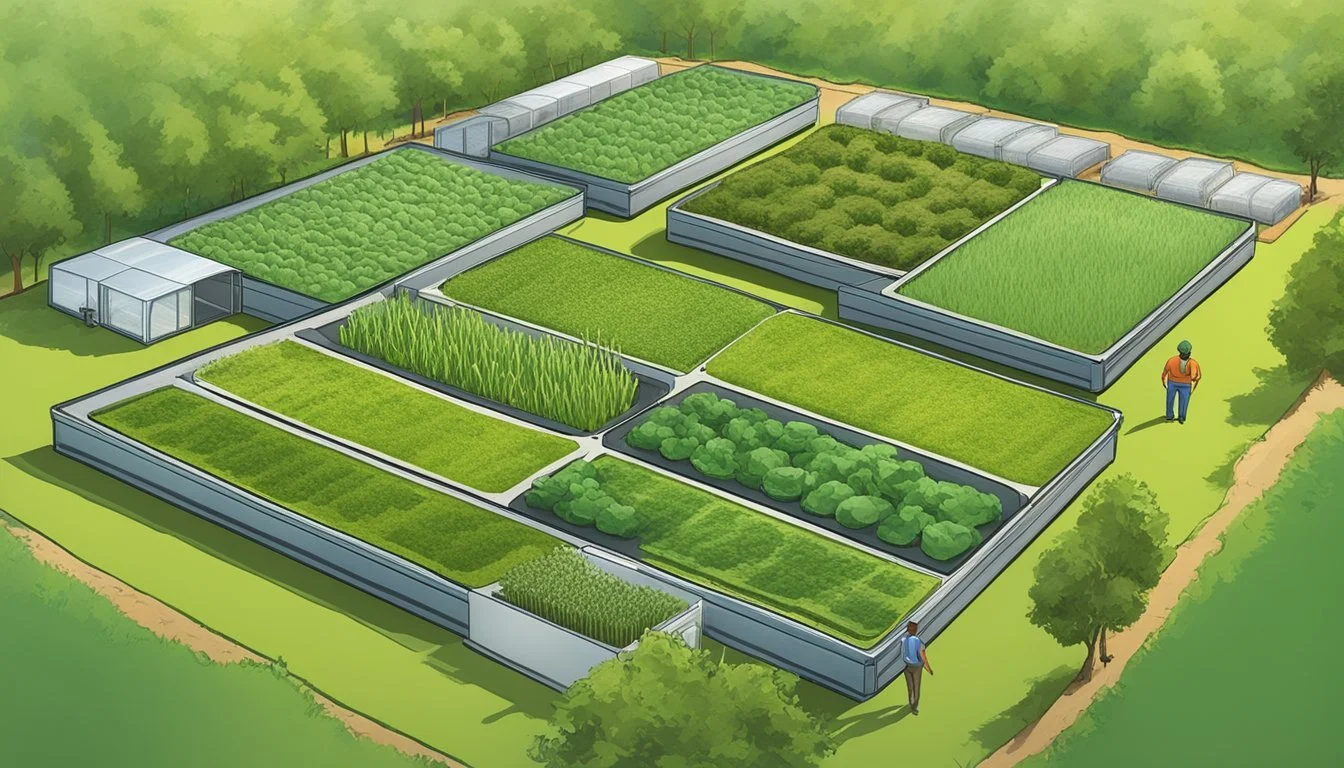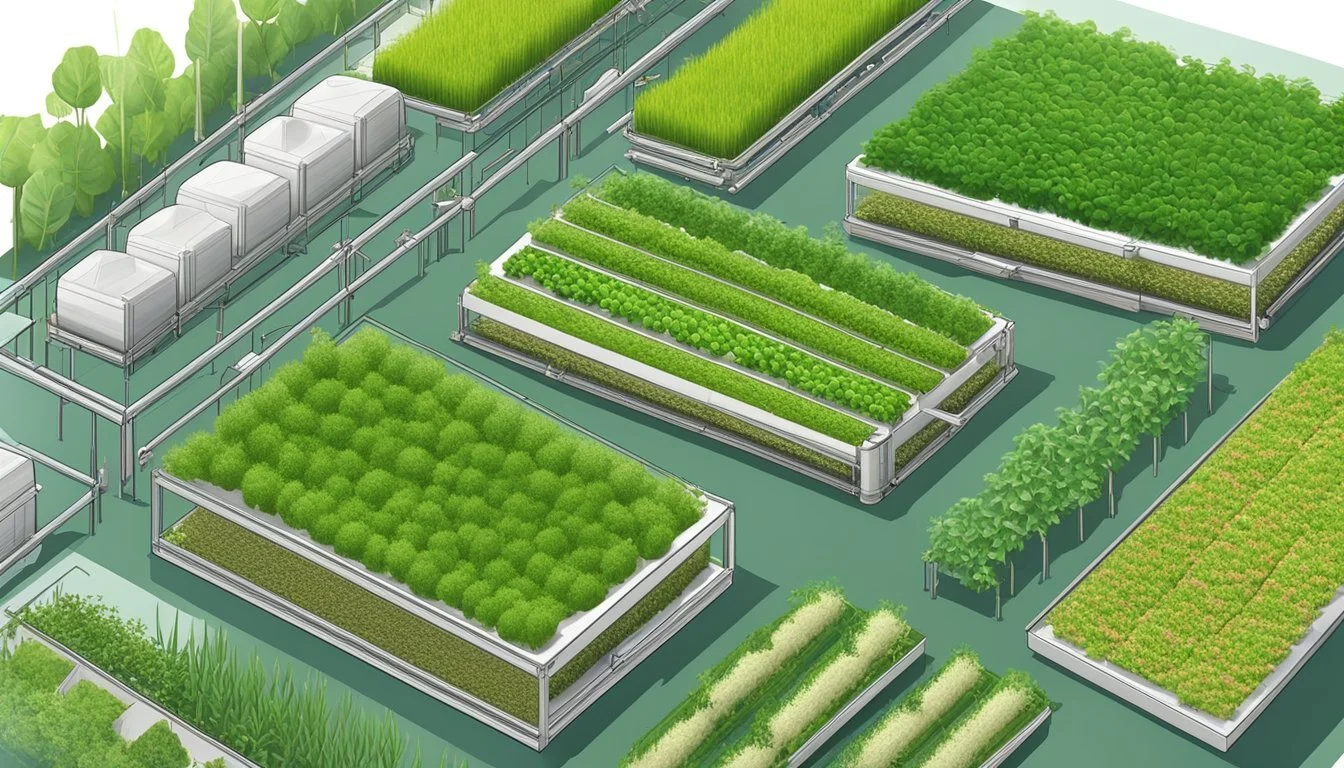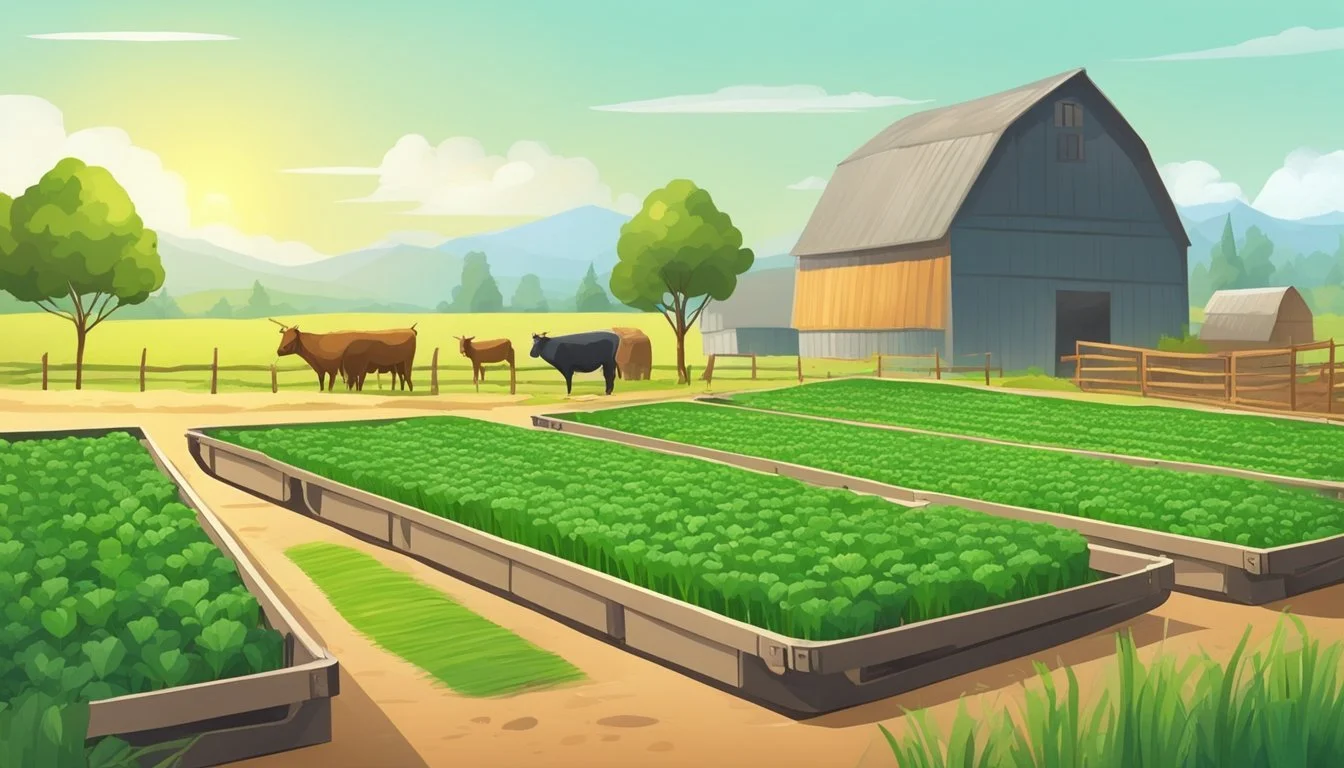Ultimate Guide to Fodder Growing Systems for Homestead Animal Feed
Efficient Techniques and Best Practices
Fodder growing systems are a sustainable approach to livestock feed management on a homestead. They allow homesteaders to cultivate their own nutrient-rich feed through the controlled germination and growth of grains such as barley, wheat, and oats. This method of feed production ensures a consistent supply of fresh fodder, which can be particularly advantageous for those seeking to enhance their self-sufficiency and reduce reliance on commercial feeds.
Implementing a fodder system involves a series of steps that foster the optimal growth of sprouts. These steps usually commence with the soaking of seeds to initiate germination, followed by a period of growth in trays where conditions such as light, temperature, and moisture are carefully managed to encourage sprout development. The result is a mat of highly digestible and nutritious fodder, ready to be harvested and fed to various types of livestock.
Homesteaders benefit from the advantages of fodder systems which include improved digestibility of feed, potentially leading to better livestock health and productivity. While these systems can't entirely replace traditional livestock feeds, they can significantly complement existing feeding practices, leading to a more diversified and cost-effective diet for animals. With the proper setup and maintenance, a fodder growing system can become a key component in the efficient and sustainable management of homestead livestock feeding requirements.
Fundamentals of Fodder Growing Systems
In this section, the reader will gain insight into the core principles of creating and maintaining a fodder growing system as well as the advantages such systems offer for livestock nutrition and health.
Understanding Fodder
Fodder refers to any agricultural foodstuff used specifically to feed domesticated livestock, such as chickens, rabbits, sheep, goats, and cattle. It typically consists of plant material like grains, which when sprouted, turn into a rich, nutritious feed. The process begins with seeds—often barley, wheat, or oats—that are soaked in water and then allowed to germinate and sprout. The growing systems can be as simple as trays in a rack to more elaborate setups that include automation.
Critical components of a successful fodder growing system include:
Seed: High-quality, untreated grain seeds that are capable of sprouting.
Water: An adequate supply, free of contaminants, ensuring seeds are soaked and then regularly irrigated during the sprouting process.
System: An arranged methodology, whether manual or automated, that supports the seeds through their germination cycle until ready for livestock consumption.
Benefits of Fodder for Livestock
Sprouted fodder systems offer numerous benefits for livestock, including:
Enhanced Nutrition: Fodder, once sprouted, is packed with essential nutrients, including vitamins, minerals, and enzymes, which are crucial for the overall health and growth of animals.
Digestibility: The sprouting process breaks down the seeds' antinutrients, making the fodder more easily digestible for livestock.
Economical: It is cost-effective, as it can reduce reliance on commercially purchased feeds and extend existing feed supplies.
Year-Round Feed: Systems can be maintained in any climate, allowing homesteaders to grow fresh feed throughout the year, regardless of the season.
Employing a sprouted fodder system is a strategic approach to sustainably providing livestock with a high-quality, nutritious feed that supports their well-being and productivity.
Setting Up Your Fodder System
Proper establishment of a fodder system is crucial for efficient and sustainable feed production for livestock. This section provides a clear pathway to select the right seeds, ensure water quality, and choose appropriate containers for setting up a productive fodder system.
Selecting the Right Seeds
When beginning a fodder system, selecting the highest quality seeds is the first step. One should look for seeds that are known for their high germination rate and vigorous growth. Barley, oats, and wheat are popular choices due to their nutritional value and ease of sprouting.
Seeds to consider:
Barley: High germination rate, good for temperate regions.
Oats: Preferred in cooler climates.
Wheat: Commonly used, fast sprouting.
All seeds should be free from mold and contaminants. Buying from reputable suppliers can ensure the quality and purity of seeds, which is vital for the health of the resulting fodder and the animals that will consume it.
The Importance of Good Water Quality
Water quality is paramount in a fodder system. The water used to soak and irrigate the seeds must be clean and free of harmful chemicals. High-quality water ensures proper seed germination and prevents the growth of mold or bacteria that could compromise the entire system.
To maintain the water quality:
Check the pH level: Aim for a pH between 6 to 7.
Filter the water: Remove chlorine and other potential toxins.
Monitor temperature: Cold water can slow germination, and warm water could promote mold growth.
Regular testing of water quality is recommended to ensure an optimal growing environment, leading to healthy, nutritious fodder.
Choosing the Appropriate Containers
Containers for a fodder system must be chosen with attention to detail to facilitate easy use and ensure proper growth conditions. They should have adequate drainage to prevent waterlogging and allow for the roots to access oxygen.
Container specifications:
Trays: Shallow with drainage holes.
Buckets: Used for soaking seeds, with holes drilled at the bottom.
For hydroponic systems, which grow fodder without soil, the choice of containers is even more crucial. They must be non-toxic and suitable for food production to keep the fodder safe for animal consumption. The use of trays with a slanted base can also aid in the collection of excess water, which should be drained away to prevent issues such as mold growth and root rot.
The Fodder Growing Process
The fodder growing process for a homestead animal feed system involves several key steps, each critical for ensuring healthy, nutrient-rich sprouts. One starts with the soaking of seeds, which leads to proper drainage and rinsing, and then to optimizing sprouting conditions by managing temperature and humidity.
Soaking Seeds
The initial step in the fodder growing process is the soaking of seeds, which begins the germination process. Seeds should be immersed in water for a period typically ranging from 12 to 24 hours. This helps to activate the seeds' growth mechanisms, leading to more successful sprouting. Adding a splash of hydrogen peroxide to the water can assist in preventing mold growth during soaking.
Drainage and Rinsing
Post-soaking, seeds require thorough drainage to prevent waterlogging, which might lead to mold growth. A system of drilled holes in containers ensures water is easily drained. Daily rinsing of the seeds is vital to provide them with fresh water and to remove any build-up of residues that can inhibit growth or cause rotting.
Optimizing Sprouting Conditions
The seeds need to be spread in a single layer in trays to allow even sprouting and access to sunlight or appropriate artificial light. Spraying the plants with a baking soda and water solution can minimize the risk of mold. The sprouting area must have good air circulation to ensure even drying and growth.
Managing Temperature and Humidity
Maintaining an ideal temperature between 60-70°F (15-21°C) is critical for optimal seed germination and growth. A controlled environment helps to avoid overheating and ensures a consistent humidity level, which should be monitored and adjusted to avoid excessive dampness that promotes mold.
Feeding Livestock with Grown Fodder
Grown fodder provides a cost-effective and nutritious feed option for a variety of livestock, enhancing overall animal health and production efficiency.
Integrating Fodder into Animal Diet
Introducing grown fodder into the diets of livestock should be done gradually to allow the animals to adjust. Grown fodder, being extremely digestible and rich in protein, can contribute significantly to the nutrition value of an animal's diet. It sometimes replaces a portion of conventional feed, not only reducing feed costs but also increasing nutritional benefits which can lead to higher yields of milk, meat, and eggs. The high digestibility of fodder may also mean that animals require less feed by dry weight compared to traditional feeds to achieve the same nutritional intake.
For example, cattle typically consume about 2-3% of their body weight in dry feed daily. When integrating fodder, one might start with a small percentage of this amount in fodder form and monitor the animals' health and performance, adjusting as needed.
Adjusting Feed Quantities Based on Livestock Needs
Adjusting feed quantities is essential to meet the specific needs of different types of livestock, as each species and breed has unique nutritional requirements. Parameters like body weight, stage of life, production levels (such as milk or egg production), and overall health status dictate the quantity and formulation of fodder included in the diet.
Livestock Type: Cattle
Body Weight (approx.): 1200 lbs
Fodder as % of Daily Diet: 20-30%
Livestock Type: Horses
Body Weight (approx.): 1000 lbs
Fodder as % of Daily Diet: 15-25%
Livestock Type: Sheep
Body Weight (approx.): 150 lbs
Fodder as % of Daily Diet: 20-30%
Livestock Type: Chickens
Body Weight (approx.): 5 lbs
Fodder as % of Daily Diet: 10-20%
These percentages are starting points, and one should adjust based on individual animal response and nutritional needs. It’s important to monitor the condition of the animals and adjust the diet to maintain optimal health and productivity. Additionally, fodder should not be the sole feed but a part of a balanced diet, supplemented with additional required nutrients and minerals not provided by the fodder.
Troubleshooting Common Fodder System Issues
Effective troubleshooting is imperative to maintaining a healthy fodder system. This section details two specific problems: preventing mold and ensuring consistent fodder quality, and outlines practical strategies to address these issues.
Preventing and Addressing Mold
Preventive Measures:
Temperature and Humidity Control: Maintain an environment with low humidity and a temperature range between 60-75°F to inhibit mold growth.
Adequate Air Circulation: Ensure good airflow around the fodder to keep the surfaces dry and unfavorable for mold.
Addressing Mold Growth:
Daily Inspections: Check the fodder system daily for any signs of mold and remove affected sprouts immediately to prevent spreading.
Water Quality: Use clean water and consider adding a small amount of hydrogen peroxide during the initial soak to reduce mold occurrences.
Ensuring Consistent Fodder Quality
Monitoring:
Regular Testing: Test the fodder quality periodically to ensure the nutritional value and growth consistency.
Feed Quantity Consistency: Adjust daily feed quantities to match the growth rates, ensuring that animals receive the correct nutritional intake.
System Maintenance:
Cleaning Schedules: Adopt a routine cleaning schedule for all system components to maintain hygiene and performance.
Water Consumption Monitoring: Regularly monitor and adjust water consumption rates to maintain optimal sprout growth and minimize waste.
By following these systematic approaches, one can significantly reduce the risk of common issues in fodder systems, ensuring a continuous supply of high-quality animal feed.
Advanced Strategies for Fodder Systems
In the pursuit of self-sufficiency, homesteaders often explore advanced fodder systems to optimize their animal feed production. Implementing hydroponics, scaling operations, and incorporating automation can vastly improve efficiency and yield.
Using Hydroponic Fodder Systems
Hydroponic fodder systems represent a leap in efficiency and control for growing livestock feed. Hydroponics—the practice of growing plants without soil—allows for highly precise management of nutrients and water. Roots are suspended in a water solution enriched with the necessary nutrients, which is both space-efficient and can lead to faster growth cycles compared to traditional soil methods. The key benefits are:
Water Conservation: Recirculation of nutrient-rich water reduces overall usage.
Consistent Quality: Controlled conditions ensure predictable and high-quality fodder production.
Scaling Up for Commercial Production
When scaling up a fodder system for commercial purposes, one needs to consider space utilization and workflow optimization. The following steps should be considered:
Quantitative Analysis: Assess the feed demand to determine the scale of production required.
Space Design: Maximize vertical space with tiered growing systems and consider the footprint of necessary equipment.
Bulk Purchasing: Procure seeds and nutrients in bulk to lower input costs.
Homesteaders must manage increased workload efficiently to prevent issues in larger-scale systems.
Automation and Technological Enhancements
The integration of automation and technology in fodder systems can lead to significant time savings and precision. Automation can manage tasks such as:
Watering Cycles: Ensuring plants receive the optimal amount of water without manual intervention.
Nutrient Delivery: Automated sensors can detect when nutrients are needed and supply them in precise quantities.
Climate Control: Technology can monitor and adjust temperature and humidity to promote optimal growth conditions.
Investment in technology can reduce labor and increase the consistency of the fodder produced.
Economic and Environmental Considerations
When exploring fodder systems for homesteads, economic viability and environmental impact are paramount. Reasonably calculated investments and mindful practices promise not only cost savings but also a favorable ecological footprint.
Cost Analysis and Budgeting
A detailed cost analysis is a cornerstone of any fodder growing system implementation. Anticipated expenses include:
Initial setup: Costs cover trays, racks, lighting, and irrigation components.
Ongoing operations: Expect water, electricity, and seed expenditures.
Homesteaders often see a reduction in their feed bill, as producing fodder in-house can save money over purchasing commercial feeds. Budgeting for a fodder system must account for the balance between the system's initial and operational costs versus long-term savings on animal feed.
Sustainability and Environmental Impact
Fodder systems contribute positively to environmental stewardship in the following ways:
Reduced carbon footprint: By growing feed on-site, farmers cut down on transportation emissions associated with commercial feed production and delivery.
Resource-efficient: Fodder systems use less water than traditional farming, supporting sustainability and conservation efforts.
Soil preservation: As these systems are soil-free, they prevent soil depletion and contamination from agricultural runoff, enhancing environmental quality.
Glossary and Further Resources
To fully engage with the fodder growing system, understanding the terminology is crucial. For those seeking more depth, a wealth of resources online offers detailed guidance and tools for success.
Key Terms in Fodder Growing
Fodder: The edible material grown for livestock feed.
Sprouting: The process of soaking and germinating seeds to be used as fodder.
Hydroponics: Growing plants in a water-based, nutrient-rich solution, often used in fodder systems.
Nutrient Film Technique (NFT): A hydroponic method in which a shallow stream of water containing dissolved nutrients is recirculated past the roots of plants in a watertight channel.
Additional Reading and Online Resources
Resources:
Instruction Manuals: Many online agricultural extensions provide free manuals with step-by-step instructions on setting up a DIY fodder system.
Supply Checklists: Homesteading forums and websites offer comprehensive lists of necessary supplies to begin and maintain a fodder growing operation.
Online Resources:
How-to Guides: Detailed articles and videos are available online, demonstrating the setup, daily maintenance, and troubleshooting of fodder systems.
Discussion Forums: Communities of homesteaders and farmers where individuals can seek advice, share experiences, and discuss best practices in fodder production.
By using the glossary and resources provided, one can gain both foundational knowledge and practical insight into building and maintaining efficient fodder systems for sustainable animal feed production.
Conclusion
Fodder growing systems have become a cornerstone in the quest for self-sufficiency on the homestead. They empower homesteaders with the ability to produce high-quality, nutritious feed for their livestock year-round. By incorporating such systems, they effectively reduce their dependence on commercial feeds.
One of the primary advantages of these systems is their versatility. Homesteaders can adapt the size and complexity of their fodder system to match the specific needs of their animals, ensuring a personalized approach to animal nutrition. They typically involve the cultivation of grains, like barley or wheat, which sprout rapidly and provide fresh greens that livestock readily consume.
Cost-effectiveness is another benefit. After the initial setup costs, the only ongoing expenses are seeds and minimal utilities, leading to significant savings over time. Homesteaders can observe a marked improvement in the health and productivity of their animals, which can translate to higher quality dairy, meat, and eggs.
Moreover, a well-maintained fodder system is environmentally friendly, using less water than traditional growing methods and can operate with limited space. This aligns with the homesteading ethos of sustainability and responsible resource usage.
In summary, fodder growing systems are a practical and rewarding addition for homesteaders looking to enhance the well-being of their livestock and achieve greater autonomy. The knowledge that one is feeding their animals the best possible diet instills a sense of pride and responsibility that is at the heart of homestead living.





